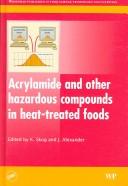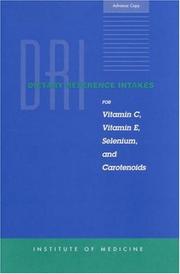| Listing 1 - 10 of 12 | << page >> |
Sort by
|
Book
ISBN: 1523114444 012809544X 0128095210 9780128095447 9781523114443 9780128095218 Year: 2017 Publisher: London, United Kingdom
Abstract | Keywords | Export | Availability | Bookmark
 Loading...
Loading...Choose an application
- Reference Manager
- EndNote
- RefWorks (Direct export to RefWorks)
Fatty acids. --- Acids, Fatty --- Carboxylic acids
Book
ISBN: 9780128161272 0128161272 0128161264 9780128161265 Year: 2020 Publisher: London ; San Diego, California : Academic Press, Elsevier,
Abstract | Keywords | Export | Availability | Bookmark
 Loading...
Loading...Choose an application
- Reference Manager
- EndNote
- RefWorks (Direct export to RefWorks)
Sialic acids. --- Acetylneuraminic acid --- Lactaminic acid --- Amino compounds --- Carboxylic acids --- Mannose
Book
ISBN: 1608053865 9781608053865 Year: 2013 Publisher: Sharjah, U.A.E. Oak Park, IL Bentham Science Publishers
Abstract | Keywords | Export | Availability | Bookmark
 Loading...
Loading...Choose an application
- Reference Manager
- EndNote
- RefWorks (Direct export to RefWorks)
The importance of substitution by the sugar sialic acid and the role played by sialylated structures (eg. glycoproteins, glycolipids, glycoconjugates) in immune recognition, neural cell growth, embryogenesis and disease development including microbial pathogenesis and cancer progression, has become well-established. This ebook presents a summary of central aspects of sialobiology (i.e., the study of sialic acid and its relevance to biology).
Sialic acids. --- Biosynthesis. --- Biological synthesis --- Synthesis, Biological --- Biochemical engineering --- Biochemistry --- Organic compounds --- Synthetic biology --- Biochemical templates --- Acetylneuraminic acid --- Lactaminic acid --- Amino compounds --- Carboxylic acids --- Mannose --- Synthesis
Book
ISBN: 1536108707 9781536108705 1536108626 9781536108620 Year: 2017 Publisher: Hauppauge Nova Science Publishers, Inc.
Abstract | Keywords | Export | Availability | Bookmark
 Loading...
Loading...Choose an application
- Reference Manager
- EndNote
- RefWorks (Direct export to RefWorks)
Caffeine. --- Acrylic acid. --- Acroleic acid --- Ethylenecarboxylic acid --- Propene acid --- Propenoic acid --- Vinylformic acid --- Alkenes --- Carboxylic acids --- Coffeine --- Dihydrotrimethylpurinedione --- Guaranine --- Methyltheobromine --- Theine --- Trimethyldihydropurinedione --- Trimethyldioxopurine --- Trimethylxanthine --- Coffee --- Methylxanthines --- Tea --- Xanthine
Book
ISBN: 040870280X 0839110340 9780408702805 Year: 1973 Volume: 6 Publisher: London : Butterworths,
Abstract | Keywords | Export | Availability | Bookmark
 Loading...
Loading...Choose an application
- Reference Manager
- EndNote
- RefWorks (Direct export to RefWorks)
Amino Acids. --- Peptides. --- 547.466 --- Polypeptides --- Acids, Amino --- Amino derivatives of carboxylic acids. Amino acids --- Amino acids. --- 547.466 Amino derivatives of carboxylic acids. Amino acids --- Amino acids --- Peptides --- Acides aminés --- Peptide --- Polypeptide --- Amino Acid --- Acid, Amino --- Amino Acids --- Molecular structure. --- Antibiotics --- Chemical actions --- Conformation --- Synthesis
Book
ISBN: 0444409505 9781483193168 1483193160 1322334552 9780444409508 Year: 1971 Volume: 18S Publisher: Amsterdam Elsevier
Abstract | Keywords | Export | Availability | Bookmark
 Loading...
Loading...Choose an application
- Reference Manager
- EndNote
- RefWorks (Direct export to RefWorks)
Pyruvate and Fatty Acid Metabolism
General biochemistry --- 57 --- Biochemistry. --- Pyruvates --- Fatty acids --- Acids, Fatty --- Carboxylic acids --- Ketonic acids --- Pyruvic acid --- Biological chemistry --- Chemical composition of organisms --- Organisms --- Physiological chemistry --- Biology --- Chemistry --- Medical sciences --- Metabolism. --- Composition
Book
ISBN: 0128230274 0128213914 9780128213919 9780128230275 Year: 2021 Publisher: Amsterdam
Abstract | Keywords | Export | Availability | Bookmark
 Loading...
Loading...Choose an application
- Reference Manager
- EndNote
- RefWorks (Direct export to RefWorks)
Omega-3 Delivery Systems: Production, Physical Characterization and Oxidative Stability offers the most recent updates for developing, characterizing, and stabilizing both traditional and novel omega-3 delivery systems, including their final incorporation into food matrices and physicochemical changes during digestion. The book brings chapters on novel omega-3 delivery systems (e.g., high-fat emulsions, Pickering emulsions, electrosprayed capsules, and solid lipid nanoparticles), the application of advanced techniques to evaluate physical and oxidative stabilities (e.g., SAXS, SANS, ESR, and super-resolution fluorescence microscopy), and new developments of food enrichment and physicochemical changes during digestion. The book provides a unique multidisciplinary and multisectoral approach, i.e., featuring authors from industry and academy. Long chain omega-3 polyunsaturated fatty acids (PUFA) present numerous health benefits; however, the consumption of natural products rich in omega-3 PUFA (e.g., fish, krill, and algae) is not enough to reach the daily-recommended values. Therefore, the food industry is highly interested in producing omega-3 fortified foods.
Omega-3 fatty acids. --- Fatty Acids, Omega-3. --- N-3 fatty acids --- Omega-3 EFA --- Omega-3 essential fatty acids --- Unsaturated fatty acids --- High-omega-3 fatty acid diet --- Fatty acids. --- Acids, Fatty --- Carboxylic acids

ISBN: 1845692012 9781845692018 1845690117 9781845690113 0849390966 9780849390968 Year: 2006 Publisher: Boca Raton, FL CRC Press
Abstract | Keywords | Export | Availability | Bookmark
 Loading...
Loading...Choose an application
- Reference Manager
- EndNote
- RefWorks (Direct export to RefWorks)
Although the aim of cooking foods is to make them more appetizing and microbiologically safe, it is now known that cooking and food processing at high temperatures generate various kinds of toxic substances, such as heterocyclic amines and acrylamide, via the Maillard reaction. Summarising the latest research in this field, this important collection discusses both the formation of health-hazardous compounds during heat treatment of foods and practical methods to minimise their formation.Part one analyses the formation of hazardous compounds in heat-treated foods such as meat, potatoes,
Environmental Pollution --- Food Safety --- Acrylamides --- Temperature --- Weather --- Food and Beverages --- Public Health --- Technology, Industry, Agriculture --- Atmosphere --- Acrylates --- Amides --- Thermodynamics --- Meteorological Concepts --- Environment and Public Health --- Organic Chemicals --- Acids, Acyclic --- Physical Phenomena --- Carboxylic Acids --- Environment --- Chemicals and Drugs --- Health Care --- Ecological and Environmental Phenomena --- Phenomena and Processes --- Biological Phenomena --- Hot Temperature --- Acrylamide --- Food Contamination --- Food
Periodical
ISSN: 15589331 0003021X Year: 1947 Publisher: Champaign, IL : American Oil Chemists' Society Press,
Abstract | Keywords | Export | Availability | Bookmark
 Loading...
Loading...Choose an application
- Reference Manager
- EndNote
- RefWorks (Direct export to RefWorks)
Oils and fats --- Soap --- Acides gras --- Aliments --- Huiles et graisses --- Savon --- Oils and fats. --- Soap. --- Oliën. --- Chemie. --- Food-Processing Industry. --- Industrie et commerce --- Fats --- Food-Processing Industry --- Industry, Food-Processing --- Food Processing Industry --- Food-Processing Industries --- Industries, Food-Processing --- Industry, Food Processing --- Soaps --- Animal oils --- Grease --- Oil --- Lipids --- Cleaning compounds --- Hygiene products --- Lubrication and lubricants --- Rendering industry --- Fats. --- Chemistry. --- Oils. --- Fatty acids --- Food industry and trade --- Huiles et graisses. --- Acids, Fatty --- Carboxylic acids --- Food industry and trade. --- Fatty acids. --- Food preparation industry --- Food --- Food processing industry --- Food technology --- Food trade --- Agricultural processing industries --- Processed foods --- Processing

ISBN: 0309069491 0309069351 0309597196 9780309597197 0305069491 0305069351 Year: 2000 Publisher: Washington, D.C. : National Academy Press,
Abstract | Keywords | Export | Availability | Bookmark
 Loading...
Loading...Choose an application
- Reference Manager
- EndNote
- RefWorks (Direct export to RefWorks)
Antioxidants. --- Reference values (Medicine) --- Vitamin C. --- Vitamin E. --- Carotenoids. --- Nutritional Requirements. --- Ascorbic Acid. --- Reference Values. --- Selenium. --- Antioxydants --- Valeurs de référence (Médecine) --- Vitamine C --- Caroténoïdes --- Sélénium --- Reference values (Medicine). --- Terpenes --- Sugar Acids --- Polyenes --- Weights and Measures --- Pigments, Biological --- Cyclohexenes --- Benzopyrans --- Nutritional Physiological Phenomena --- Chalcogens --- Minerals --- Carbohydrates --- Acids, Acyclic --- Biological Factors --- Hydroxy Acids --- Inorganic Chemicals --- Physiological Phenomena --- Hydrocarbons --- Cyclohexanes --- Pyrans --- Elements --- Investigative Techniques --- Heterocyclic Compounds, 2-Ring --- Alkenes --- Carboxylic Acids --- Hydrocarbons, Acyclic --- Cycloparaffins --- Chemicals and Drugs --- Analytical, Diagnostic and Therapeutic Techniques and Equipment --- Heterocyclic Compounds --- Phenomena and Processes --- Organic Chemicals --- Hydrocarbons, Alicyclic --- Hydrocarbons, Cyclic --- Ascorbic Acid --- Nutritional Requirements --- Carotenoids --- Reference Values --- Selenium --- Vitamin E --- Nutrition --- Valeurs de référence (Médecine) --- Caroténoïdes --- Sélénium --- Requirements. --- Biochemical reference values --- Clinical reference values --- Medical reference values --- Normal ranges (Medicine) --- Normal values (Medicine) --- Physiological reference values --- Ranges, Reference (Medicine) --- Reference ranges (Medicine) --- Values, Reference (Medicine) --- Carotinoids --- Chromolipids --- Lipochromes --- Luteins --- Tocopherol --- Ascorbic acid --- Clinical chemistry --- Chemical inhibitors --- Pigments (Biology) --- Isopentenoids --- Vitamins, Fat-soluble --- Hydroxy acids --- Vitamins, Water-soluble
| Listing 1 - 10 of 12 | << page >> |
Sort by
|

 Search
Search Feedback
Feedback About UniCat
About UniCat  Help
Help News
News